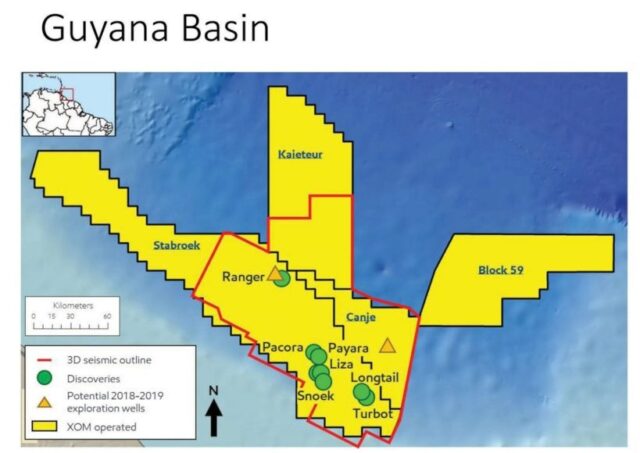ExxonMobil Guyana Limited (EMGL) has initiated a search for suppliers to provide seafloor seismic services within the Stabroek Block. This endeavour, the company said, is part of its ongoing commitment to exploring and developing the extensive hydrocarbon resources in the region.
In its published Request for Information (RFI)
Exxon outlined the specific requirements for potential suppliers. The primary focus is on the provision of advanced seafloor seismic services that can operate effectively in deepwater conditions ranging from approximately 500 meters to 2500 meters.
One critical component of the RFI pertains to the deployment and use of Ocean Bottom Nodes (OBN) as seismic receivers. These nodes are expected to be deployed via remotely operated vehicles (ROVs) and will cover an extensive area, potentially exceeding 650 square kilometers. Suppliers must demonstrate their ability to deploy and maintain a substantial number of nodes, with the capability to handle upwards of 2650 nodes actively recording data at any given time. The deployment and recovery of these nodes will require a dedicated vessel equipped for such operations.
In addition to the receivers, the RFI specifies requirements for the seismic source arrays. These sources will utilize compressed air and will be deployed from a dedicated vessel in a dual-source configuration. The provider must show proficiency in operating these sources over extensive areas, greater than 1100 square kilometers, and over extended periods of time, typically a month or more.
A crucial aspect of the project is the quality control and processing of the seismic data. The provider must possess substantial experience in data quality control for OBN seismic data systems and be capable of conducting preliminary data processing offshore. This ensures that the data collected meets the high standards required for accurate geological analysis and decision-making.
The company was keen to note that safety and operations management are paramount in its operations. The prospective supplier must have robust health, safety, and environmental management systems in place, aligning with the standards set forth by the International Association of Oil & Gas Producers (IOGP) and the EnerGeo Alliance’s guidelines on managing health, safety, and environmental (HSE) issues in geophysical contracts.
EMGL also emphasized the importance of local content in their operations. The company’s local content strategy is a critical component of its business model, integrating local workforce and supplier capabilities into daily processes and long-term planning. As such prospective contractors are required to demonstrate their understanding and application of Local Content Act of 2021 in their proposals.
The purpose or sea floor seismic surveys is to obtain high-resolution subsurface images of the geological formations beneath the seafloor. These surveys are critical for identifying hydrocarbon reservoirs with greater accuracy, reducing the risk associated with drilling operations, and optimizing the placement of wells.
The deployment of advanced seismic technologies in the Stabroek Block is expected to provide valuable data that will guide future drilling and development decisions.













